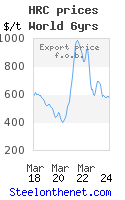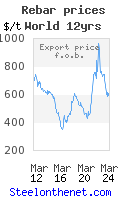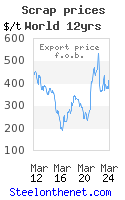Can India be the next China [MEPS]?
India is currently the world’s 8th largest steel producing country – with nearly 33 million tonnes of crude steel output in 2004 – and is increasingly being talked of as the next China. With a 12 percent increase in supply in the first half of this year, Indian steel production is growing strongly. Now the government is working on plans for a massive expansion. But, unless Indian demand also rises quickly, excess capacity will develop and put pressure on world markets.
The Indian government’s new National Steel Policy has not yet been approved, but steel minister Ram Vilas Paswan recently revealed its broad outlines to parliament. The chief goal is to increase steel production to 110 million tonnes by the 2019/20 financial year. This would mean tripling the current rate.
Because the government no longer regulates the steel sector, as it did until the early 1990s, it does not actively plan or implement steelworks expansions – other than at the state-owned companies. It now sees its role as facilitating growth by removing impediments and bottlenecks, particularly on the supply side of the industry.
So the new policy will include a series of measures designed to improve the availability of raw materials such as iron ore and coal. It will also encourage the creation of infrastructure such as the roads, railways and ports that will be required to support the steel industry’s growth.
Iron ore supply is a sensitive issue in India. The country has large reserves of high-grade material, but some of the mining, processing and transport facilities are inadequate. The government is expected to take steps to restrict exports in order to ensure a sufficient supply to the expanding domestic industry.
India is currently the world’s third largest iron ore exporting nation – behind Australia and Brazil – and local traders have been largely responsible for the development of a substantial spot market to cater for Chinese demand. This business may be curbed if the ore is needed to keep domestic mills supplied.
Coal is a different matter. India has large reserves of coal, but the quality is such that it needs to be blended with imports of high-grade coking coal to produce adequate blast furnace feed material. From time to time, a shortage of coking coal has constrained Indian steel production; hence the government is encouraging steel companies to secure supplies by investing in coal mines abroad. Tata Steel recently bought a stake in an Australian mine.
Many Indian steel makers already have plans to raise their production in line with the government’s target. State-owned enterprises, Sail and Vizag, propose adding a total of about 14 million tonnes of annual capacity by 2010/12. Tata Steel is raising output at its existing works from 5 million tonnes per year to 7.5 million tonnes per year and is also contemplating a new works of 5 million tonnes annual capacity. Many other private sector steel companies are implementing plans for multi-million-tonne expansions.
The government says it also wants to attract more foreign investment in steel. The biggest foreign-backed project so far is Posco’s intention to build a new plant in eastern India to take advantage of local iron ore. This unit will have an initial capacity of 3 million tonnes per year, rising eventually to 12 million tonnes annually. Among the other companies looking at investing in India is Mittal Steel, the world’s largest producer, which is domestically owned.
The government acknowledges India’s low per capita steel consumption – less than 30kg compared with the world average of about 150kg – and says it wants to stimulate growth in demand to improve the quality of life, especially in rural areas. So the new steel policy will include measures to strengthen distribution channels, to develop new steels suited to rural needs, and promote the use of the material generally.
India’s per capita steel consumption has increased by close to 50 percent in the last ten years. But a lot more will have to be done if it is to grow in line with production – as this means rising threefold in the next 15 years. India has China for a model, but it remains to be seen whether such large-scale advances in demand are achievable.
It is relatively straightforward to install new steelmaking capacity, but not easy to develop new markets to consume it. The clear danger is that India will build up a large additional steel producing potential without having a comensurate domestic market. The country could then become a significantly bigger exporter, with potentially disruptive consequences for steel markets in other regions of the world.
Source: MEPS International Steel Review
The Indian government’s new National Steel Policy has not yet been approved, but steel minister Ram Vilas Paswan recently revealed its broad outlines to parliament. The chief goal is to increase steel production to 110 million tonnes by the 2019/20 financial year. This would mean tripling the current rate.
Because the government no longer regulates the steel sector, as it did until the early 1990s, it does not actively plan or implement steelworks expansions – other than at the state-owned companies. It now sees its role as facilitating growth by removing impediments and bottlenecks, particularly on the supply side of the industry.
So the new policy will include a series of measures designed to improve the availability of raw materials such as iron ore and coal. It will also encourage the creation of infrastructure such as the roads, railways and ports that will be required to support the steel industry’s growth.
Iron ore supply is a sensitive issue in India. The country has large reserves of high-grade material, but some of the mining, processing and transport facilities are inadequate. The government is expected to take steps to restrict exports in order to ensure a sufficient supply to the expanding domestic industry.
India is currently the world’s third largest iron ore exporting nation – behind Australia and Brazil – and local traders have been largely responsible for the development of a substantial spot market to cater for Chinese demand. This business may be curbed if the ore is needed to keep domestic mills supplied.
Coal is a different matter. India has large reserves of coal, but the quality is such that it needs to be blended with imports of high-grade coking coal to produce adequate blast furnace feed material. From time to time, a shortage of coking coal has constrained Indian steel production; hence the government is encouraging steel companies to secure supplies by investing in coal mines abroad. Tata Steel recently bought a stake in an Australian mine.
Many Indian steel makers already have plans to raise their production in line with the government’s target. State-owned enterprises, Sail and Vizag, propose adding a total of about 14 million tonnes of annual capacity by 2010/12. Tata Steel is raising output at its existing works from 5 million tonnes per year to 7.5 million tonnes per year and is also contemplating a new works of 5 million tonnes annual capacity. Many other private sector steel companies are implementing plans for multi-million-tonne expansions.
The government says it also wants to attract more foreign investment in steel. The biggest foreign-backed project so far is Posco’s intention to build a new plant in eastern India to take advantage of local iron ore. This unit will have an initial capacity of 3 million tonnes per year, rising eventually to 12 million tonnes annually. Among the other companies looking at investing in India is Mittal Steel, the world’s largest producer, which is domestically owned.
The government acknowledges India’s low per capita steel consumption – less than 30kg compared with the world average of about 150kg – and says it wants to stimulate growth in demand to improve the quality of life, especially in rural areas. So the new steel policy will include measures to strengthen distribution channels, to develop new steels suited to rural needs, and promote the use of the material generally.
India’s per capita steel consumption has increased by close to 50 percent in the last ten years. But a lot more will have to be done if it is to grow in line with production – as this means rising threefold in the next 15 years. India has China for a model, but it remains to be seen whether such large-scale advances in demand are achievable.
It is relatively straightforward to install new steelmaking capacity, but not easy to develop new markets to consume it. The clear danger is that India will build up a large additional steel producing potential without having a comensurate domestic market. The country could then become a significantly bigger exporter, with potentially disruptive consequences for steel markets in other regions of the world.
Source: MEPS International Steel Review




1 Comments:
Interesting article Andrew, I will link to it in my next post.
Post a Comment
<< Home